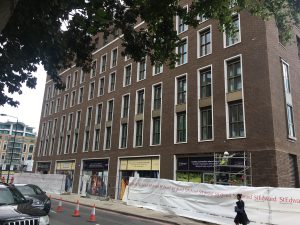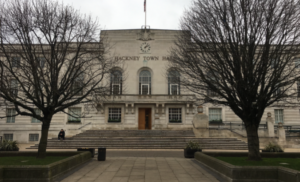Philip Glanville has been Hackney’s directly elected Labour Mayor since September 2016 and before that was a Labour councillor in the borough for ten years, the last three of them as cabinet member for housing.
The London Borough of Hackney is, in many ways, the poster child for place improvement. There are few places in the UK that have undergone such wholesale change in such a short period of time. In about a decade and a half, Hackney has gone from being one of the least to the most desirable places to live in the UK. There’s no doubt the place has changed, and most people would agree that it has changed for the better, but this of course brings with it new challenges about how we respond to and shape change to keep benefiting everyone.
I’m the last person to see the quality of a place through the prism of property adverts or an estate agent’s window, and deeply dislike the clumsy rebranding of areas of our capital that often comes with regeneration. However, any London estate agent will tell you that the two things that drive “desirability” in the capital are good schools and public transport infrastructure. Those two things were in very short supply in Hackney at the dawn of the new millennium, until the transformation of education and the birth of the London Overground changed everything. But for politicians and decision makers improving a place shouldn’t be about making it more desirable; it should be about transforming the quality of life and the life chances of the people who live there. That has been the driving force behind improving Hackney, both under my predecessor Jules Pipe and since my own election in 2016.
In the early days, improving Hackney was all about getting the basics right; street cleaning, waste collection, benefits processing, council tax collection, financial management – the fundamentals of municipal duty that had been all but abandoned in the late 1990s. Hackney back then was literally and metaphorically struggling to keep the lights on. Correcting those mistakes and taking our services, and in turn Hackney the “place” from the worst in London to amongst the best, wasn’t easy and required painstaking political and organisational change, as well as real investment. It is on that bedrock of financial stability and excellent local services that Hackney’s success as a place has been built. After that it was about ambition, about never being satisfied with being “just OK”, never making excuses for poor services, about taking full advantage of every opportunity that came our way, about being ambitious for Hackney and its communities.
There has also been an element of good luck. Hackney was in the right place at the right time. We had a Labour government willing to support the council’s leadership in turning the ship around, and to quite substantially put its money where its mouth was. We had a decade, under that government, of unprecedented investment in public services and infrastructure. We had some freedom to spend that money creatively, finding new ways to tackle ingrained inequalities such as teen pregnancy and infant mortality. We had the 2012 Olympic and Paralympic Games on the horizon as a catalyst for change, investment and civic pride. And Hackney has always been lucky in that underneath the grime, the crime, and the service dysfunction, lay the bare bones of a fantastic place: street after street of high quality Victorian housing stock close to central London, high volumes of good social housing, acres of parks and green space, miles of waterways, plenty of state schools, a large hospital in the heart of the borough, quiet residential roads and vibrant town centres.
But there was a lot more to it than luck. Turning Hackney round was a labour of love for many people in the council, in our partner agencies and organisations, and most of all in our communities. So much needed to change: the council, its services, its relationships and its reputation. And the reputation of Hackney itself needed to change to attract jobs, investment, and visitors, to grow the local economy and create opportunity for local people. Perhaps the best thing we had to work with was our residents, people that believed in Hackney, even when many others had given up. There was a sense that Hackney and its numerous communities and neighbourhoods was a real place, not just invented by the stroke of a Whitehall pen in the 1960s or by a Town Hall bureaucrat; a Hackney of migrants, radical pioneers, campaigners, entrepreneurs, active citizens, and organisers; most of all a diverse and tolerant place where change was welcomed, shaped and embraced.
A key element of success was in tapping into that underlying, often hidden self belief, curating it, rebuilding and sustaining a cohesive, shared, pride of place. The I Love Hackney campaign, now in its twelfth year, is still a vital tool in maintaining that shared notion of place, and more and more we are using it to celebrate the diverse and inclusive nature of our communities. It wouldn’t still be relevant now and embraced by residents and visitors alike if it had been a cynical act of rebranding disconnected from what people really felt. Most recently it has been reworked to highlight the borough’s new digital economy, to celebrate Pride and the contribution of the LGBTQI+ community and to show solidarity with the 40,000 Hackney residents who are EU nationals in the wake of the Brexit vote.
Since I was elected Mayor in 2016 and re-elected this year, it has also been about reasserting and holding true to our own values, which many of our residents share: a commitment to council owned social housing, keeping services in-house where possible, investing in public infrastructure, a role for the council in education, training and skills, a commitment to the idea of a borough that belongs to all who live here. As Mayor it was about being proud to say we are a campaigning council, which acts when these values are seen to be under attack, standing up not just for services, but also a collective sense of Hackney. All of that has built a shared sense of place that is, I believe, amongst the strongest in the country. I Love Hackney was born out of the Council’s response to a Channel 4 property programme calling Hackney ‘The Worst Place to Live in the UK”. It’s hard to believe that was little more than a decade ago when you look at how far we’ve come since then. Back then, wearing the badge was often met with quizzical looks or even derision, now they are collectors items and I often have to take off my own to give to people when I am out and about in Hackney and beyond.
However much Hackney has changed though, it is still home to some of the UK’s most deprived communities and the challenges facing us now, whilst different, are as acute as they were 15 years ago. The streets are clean, the schools are outstanding, estates and council homes renewed, and crime is significantly lower than it was in the days of “Murder Mile“. But after eight years of austerity, with its devastating impact on individuals as well as services, it can feel as though we are running to stand still.
How can we keep delivering first class public services when money is draining away from councils and demand for them is rising rapidly? How can we maintain our work in school improvement with a government hell-bent on fragmenting the education system? How can we keep our streets and estates safe when police numbers have been decimated? How can we keep our communities strong and cohesive, and make sure that people aren’t excluded from the benefits of change? How can we make an impact on the huge, complex areas of policy that affect our residents, such as air quality, violent gang crime and childhood obesity? And how can we make sure that as Hackney changes it remains true to the values on which our communities were built? These are the challenges we are facing every day, for which we are having to find ever more creative solutions.
The truth remains that for many people in Hackney, life has got harder as the borough has improved around them. House prices have risen more here than anywhere else in the UK. Rents have increased by 20% in five years. As it has improved, Hackney has also become closed to many who in the past would have made it their home. Living here has become a struggle for others as the cost of living in the borough has increased, and many residents are concerned that their children will be forced to move away. Some residents feel displaced or excluded by the new demographic, and by the changing face of our high streets. That emotional impact of change should not be underestimated. It’s why we have to work doubly hard to say whose side we are on and what we believe in. It’s why I’m so passionate about retaining the economic, ethnic and social diversity of the borough and especially our markets and town centres like Dalston, which can often feel at risk from gentrification.
Some residents of Hackney, even those who may have gained financially from rocketing house prices, feel ambivalent about the notion of improvement. They are benefitting from many aspects of the change, but feel that something fundamental about the place and its values may be under threat – that “gentrification” may have edged out “regeneration”. Hackney is still changing rapidly. Some of that change is driven by the local authority, and some is beyond our control. Local people don’t make that distinction. It is easy for communities and individuals to feel quickly overwhelmed and threatened by the pace of change, and it is the responsibility of local government and elected politicians to make sure they are engaged, empowered and informed. If communities feel left behind by change, if they cannot access the benefit it brings, then any improvement narrative is a hollow one.
Change at a local level must be locally driven. Time and again, national governments have tried to create blueprint solutions to local issues, and failed. Each place faces a unique set of challenges, and only strong local government that is fully engaged with the people it serves can properly meet those challenges. Improving a place takes leadership, it takes investment and it takes time. It takes an in-depth understanding of the place, a shared commitment across agencies, business, and the third and voluntary sector (like organisations such as Renaisi which itself grew out of the Council), and for local people to be part of the change. Only with strong local government can we ensure that regeneration delivers a social dividend for communities, not just a financial dividend for developers. Whilst we remain the most centralised country in the developed world, and whilst local government is continually marginalised, under-resourced and over-controlled by Whitehall, genuine, positive, place change will still happen in some places, but there will be a far greater risk of people and communities being left behind in others.
Mayors, councillors, officers and organisations come and go. Although in Hackney people tend to stick around longer than in some other places, we are all but temporary custodians of the places we serve. If there is one lesson to be learned from Hackney’s story it is that, in that time, each of us can make a real difference. There is something about Hackney, both as a physical place and as a construct of values, that inspires passion, loyalty, commitment and creativity in those who live and work here. It is that which is the real driver of positive change in a place, and it is that which gives me confidence that Hackney’s future is bright.
This article was originally published by Renaisi, a Hackney born and based social enterprise that helps communities benefit from neighbourhood change. Thanks to them and to Philip Glanville for their permission to re-publish it here. Follow Renaisi on Twitter here and Phil here.









